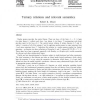Free Online Productivity Tools
i2Speak
i2Symbol
i2OCR
iTex2Img
iWeb2Print
iWeb2Shot
i2Type
iPdf2Split
iPdf2Merge
i2Bopomofo
i2Arabic
i2Style
i2Image
i2PDF
iLatex2Rtf
Sci2ools
APAL
2004
2004
Ternary relations and relevant semantics
Modus ponens provides the central theme. There are laws, of the form A C. A logic (or other theory) L collects such laws. Any datum A (or theory T incorporating such data) provides input to the laws of L. The central ternary relation R relates theories L; T and U, where U consists of all of the outputs C got by applying modus ponens to major premises from L and minor premises from T. Underlying this relation is a modus ponens product (or fusion) operation on theories (or other collections of formulas) L and T, whence RLTU i LT U. These ideas have been expressed, especially with Routley, as (Kripke style) worlds semantics for relevant and other substructural logics. Worlds are best demythologized as theories, subject to truth-functional and other constraints. The chief constraint is that theories are taken as closed under logical entailment, which clearly begs the question if we are using the semantics to determine which theory L is Logic itself. Instead we draw the modal logicians&...
| Added | 16 Dec 2010 |
| Updated | 16 Dec 2010 |
| Type | Journal |
| Year | 2004 |
| Where | APAL |
| Authors | Robert K. Meyer |
Comments (0)

